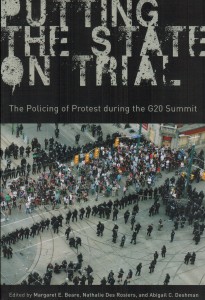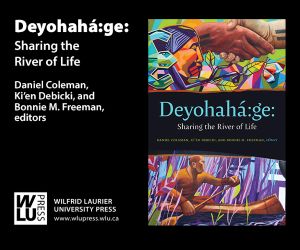Six years after the G20 riot in Toronto, there is little doubt protestors won the battle. The G20, Toronto Police, media and government – all were exposed as heavy-handed and paranoiac.
Putting the State on Trial is an eloquent collection of essays dissecting 72 hours in June, 2010 that smashed reputations to smithereens. Nobody – not government, not police, not media – looks good in this saga, save protestors themselves who exercised their right to dissent. “The riot gear, the verbal assaults, the seemingly irrational physical abuse on hapless citizens caught in the maze, and the initial denial by the police that any of the actions were indicative of an out-of-control policing operation, sparked outrage,” authors write.
The facts: the federal cabinet insisted on holding the summit in Canada’s largest city. Then the Ontario cabinet cordoned off five square blocks of downtown Toronto under an obscure 1939 law intended to protect power plants from Nazi saboteurs. Under Regulation 233/10 any person could be arrested for entry, or failing to provide ID. It became “a trap for those who exercised their ordinarily legal rights,” as Ontario’s ombudsman later observed.
Here for the first time Canadians learned of a police practice called “kettling”, where people were penned behind barricades for hours till they were photographed and identified by constables. That’s against the law in this country.
Toronto officialdom stumbled into the G20 fiasco even with the benefit of hindsight. At a 1999 WTO riot in Seattle, police arrested 600 people in a similar security operation gone berserk. The fallout saw the police chief resign, the mayor lose office, and the WTO suffer embarrassing scrutiny over its corporate practices. “The WTO was never the same,” wrote David Postman, a Seattle Times reporter who covered the protests; “Neither was the art of street protest or the chore of policing major political events.”
In Toronto, politicians and police were persuaded the answer was a bigger stick. Media broadcast fears that dangerous “Black Bloc” anarchists threatened public safety. I can think of worse crimes than kicking out the window at a Starbucks franchise, but that weekend in June Toronto lost its head. One State on Trial essayist, Prof. Kent Roach of the University of Toronto, offers an explanation.
“If 9/11 had not happened, would over 1,100 arrests have been made?” Roach writes. “Would the use of arrests as a form of disruption and incapacitation with low levels of subsequent prosecutions have been tolerated? Would $1 billion have been spent and over twenty thousand police and military been deployed in a time of global economic recession?”
“The idea that protestors could become terrorists influenced some police thinking and responses,” Roach concludes. Of 1,105 people arrested during the summit, only 321 were later summoned to court. Of those, 204 saw the charges stayed or dismissed – including Courtney Winkels, 20, famously arrested after blowing soap bubbles at police in an incident captured on YouTube video.
Canadians were told the G20 protestors were “bastards” (Toronto Sun); “the violent dregs of nihilism” (Toronto Star); “thugs” (Barrie Examiner); “brick throwers” who were “hoping to get bopped on the head by a policeman and make the nightly news” (Globe & Mail); “hooligans”, “malcontents”, “losers” and “ne’er do wells” (Rex Murphy, CBC The National).
How could so many people get this so wrong? “Media adopted a communication strategy that emphasized danger and engineered fear,” State on Trial concludes; “Clearly newspapers – and in fact all media – should adopt a far more skeptical stance toward such warnings in future.”
Putting the State on Trial is a crisp, probing analysis of state-sanctioned stupidity and lawlessness. Anyone is better for reading it.
By Holly Doan
Putting the State on Trial: The Policing of Protest during the G20 Summit; edited by Margaret E. Beare, Nathalie Des Rosiers and Abigail C. Deshman; University of British Columbia Press; 396 pages; ISBN 9780-7748-28307; $32.95








